Face-Off: Batman: Return to Arkham
A dynamic duo of Unreal Engine 4 remasters?
At the very least, the Batman: Return to Arkham remasters are an interesting technical exercise, bringing the newer features of Unreal Engine 4 to two older classics - Arkham Asylum and its sequel Arkham City. Each were originally built on a modified Unreal Engine 3, but developer Virtuos (best known for the Final Fantasy X and X-2 HD remaster) chooses to revamp its character models, overhaul its lighting, and add higher resolution effects across both. The visual changes are often striking - but sadly, glaring issues with performance can't be overlooked.
In the absence of a PC release, the brute force offered by a hardware upgrade can't address the struggling frame-rates. However it does create an interesting setup for a comparison, letting us pit these PlayStation 4 and Xbox One conversions against the original PC code running at max settings. It's worth stating right away that the Nvidia PhysX enhancements on PC remain locked to that platform, and neither console gets the physics-based smoke, particles and debris. But putting this aside, what are the key changes of this remaster?
First up there's the obvious: the character models. Much like Virtuos' work on Final Fantasy X and X-2 HD, the game's vibrant cast of heroes and villains are given facelifts to varying degrees. Such changes may irk those familiar with the original's stylistic direction; in some cases details are simply amplified, in others we get wholesale overhaul. A case in point: the Penguin gets a complete revamp of skin shaders across his face, adding more stubble in the remaster, and generally rearranging all scarring detail on his forehead. Even his monocle is given a crisper glass material, now uncomfortably crammed into his eye socket. It's one of the most striking changes in the game - but better? It's up for debate.
Other characters like Two Face and Catwoman only get a slight tweak by comparison, where facial detail and animations are identifiably the same as before. For the most part, changes to lighting create the bigger shift where these characters crop up; a shift in colour grading and light sources that cast shadows in different directions. These changes even translate to the game's many pre-rendered cut-scenes: each is thankfully re-encoded using the new engine, with all the remodeled characters and lighting factored in.
Regardless of where you stand on the characters, one aspect that's clearly improved is the use of materials used across both Arkham Asylum and Arkham City. Clothing gets a big upgrade: stitching on Harley Quinn's corset is higher resolution, and there's a more crisply detailed material used across Batman's cape. The remaster mimics the appearance of leather grain here, where before there was a simpler, plastic-like look to suits and capes. That being said, it's not always an improvement: texture quality on Hugo Strange's lab-coat is swapped to leave a plainer normal map in its place, now missing the knitted pattern of the original. Equally disappointing is the reworked hair on PS4 and Xbox One, now producing rougher, less natural results by comparison to PC at max settings.
In other words, the Return to Arkham changes are appreciated in some cases, but clearly there's an artistic misstep in others. Improvements that are undeniably a step forward include the added textures and objects across the world, especially in Arkham City. PS4 and Xbox One enjoy completely new assets, such as the reshly laid out carpets on the very first scene with Catwoman, adding to the décor of the room. Everything else appears in place, but these subtle touches help fill out otherwise barren spots - and apply to the world outside too.
The other significant change Unreal Engine 4 brings is in the lighting. On console we get enhanced bloom across Arkham city's many neon signs, a more effusive, brighter effect. On the rain-slicked roads below, the light even produces wider, more exaggerated reflections than the original game. The same goes for flames in the smelting chamber - and fire now directly casts light onto nearby surfaces, where even particle effects produce light in the remaster. On the other hand the PC original has its strong points here too; in an early sequence with Bruce chained up, it's curious to see a much stronger bloom and lens flare instead.
There are obvious drawbacks to the remaster's approach to lighting. For example, the stylish light shaft effect is missing for several scenes during Arkham City - and while still used around objects obscuring the moon, it's massively dialled back in those cases. Another curious omission is the depth of field effect, where the focal blur once used across Arkham's distance buildings is missing in the remaster. Everything is in clear view, and the same goes for interior shots with a focus on a foreground character; PS4 and Xbox One versions skip this effect.
The range of graphical changes is considerable. Some are a marked improvement in bringing out the original's details, others a step back - while there are a host of points that lay somewhere in-between. The core gameplay and physics are the same as ever though, and with cloth physics on Batman's cloak working to the same logic it had before. We even see a clear upgrade in effects quality for fire, where alpha is delivered at a far higher grade than the PC's best settings. It's a small change, and you can see everything around it animates as before, but with a sharper, higher grade alpha effect.
Putting PC aside for a moment, let's focus on the difference between PS4 and Xbox One. Native resolution is a big sticking point that weighs heavily on how each version looks. A dynamic framebuffer is used on both consoles, adjusting the pixel count based on a scene-by-scene basis. Curiously, this is handled by permanently fixing the vertical resolution to 1080 pixels on PS4 and Xbox One, while the horizontal axis scales up and down based on load. For PS4, this means we go between 1600x1080 at lowest to a full 1920x1080, but we also see numbers in between. However, Sony's machine spends the lion's share of its time at the higher end of the spectrum, producing clearer results even while in the more GPU intensive outdoors section of Arkham City.
On Xbox One we get less encouraging results. The lowest pixel count we saw is a cut-down 1024x1080, and sadly, even in Arkham Asylum's barren corridors this is a recurring figure. It's rarer to see Xbox One hit a full native 1920x1080 at best, but it's certainly doable in the first opening battle with Catwoman in Arkham City - where there are fewer demands on the engine. We see numbers in between these values, but sadly, the shortfall adds up to create an appreciable gulf in image quality between the two platforms - with textures visibly blurring over at range.
Other graphical differences are worth mentioning. For one, there's a stronger bloom effect on PS4, notably as the camera works its way around the neon signs of Arkham City. Most aspects of these games are identical on either platform, outside of resolution, but the more vibrant bloom effect sticks out consistently in favour of the PS4 release. Another curious dividing point is in ambient occlusion - a softer shading on PS4 around corners of the world. It's a minor change, but does suggest a different screen-space technique used on Xbox One , though there isn't much between them.



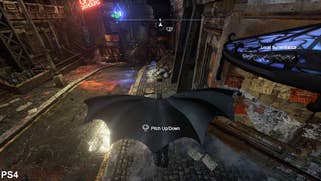


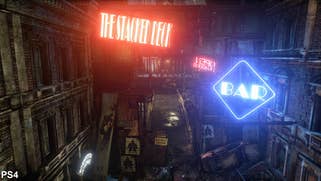
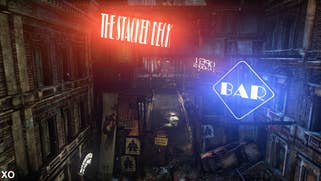


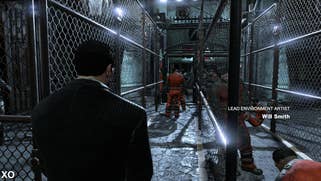
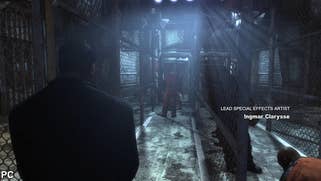
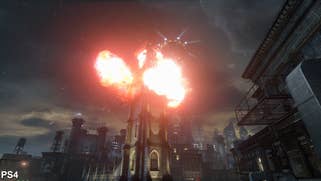

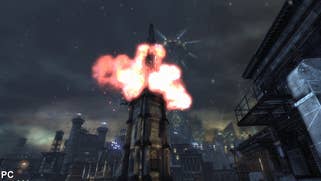
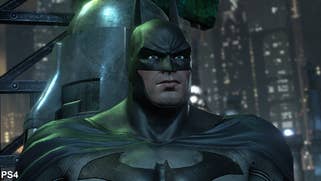

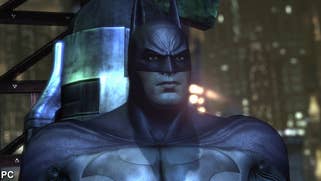
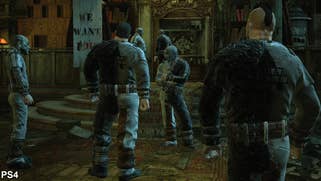
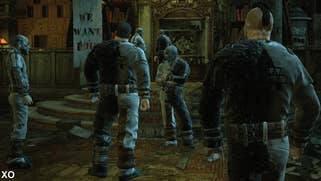
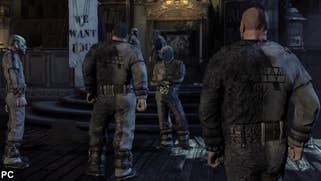



The extent of the Return to Arkham remaster's visual changes is impressive, but what of the frame-rates situation? After all, this could have been a straight port of the older PC edition, potentially giving it a stronger run at hitting 60fps on PS4 or Xbox One. Instead, developer Virtous' choice to boost visuals in each game ups the ante on each machine, leaving us with performance that isn't as consistent as we'd like on either.
Each game in the package has a different approach. To start with the more ambitious, open-world Arkham City, both PS4 and Xbox One run with an unlocked frame-rate, where v-sync is engaged to avoid screen-tear. However, this setup means we're left with a fluctuating reading on our graph that doesn't equate to a smooth visual feedback (where ideally it'd be capped to 30fps, or go the full hog and hit 60fps). On PS4, performance wavers from 20fps at lowest right up to 60fps - though for the most part we're in the 30-35fps region. Arkham City seldom holds 60fps for longer than a moment on PS4, and for a sense of consistency, a frame-rate cap at a flat 30fps would help hugely. Alas, this would still have no impact on dips below that figure.
On Xbox One it's the same story, though typically running at a lower frame-rate than PS4 - with lows of 18fps. Generally, we're looking at a Sony lead by as little as one frame per second, and as much as 20fps and beyond in matching cut-scenes. It's a wide margin that reminds us of areas in the recent Hitman reboot (another game with the option to unlock frame-rates), where the GPU is evidently a key bottleneck. Having tested these two back-to-back there's no question PS4 puts in a better, smoother delivery of Arkham City, but neither is 100 per cent ideal to play in this state.



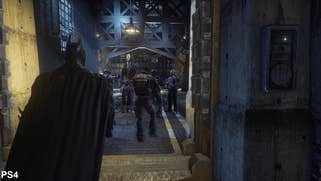
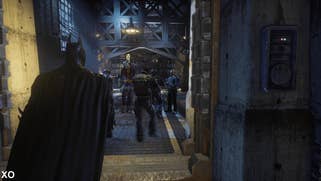

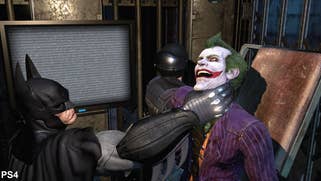



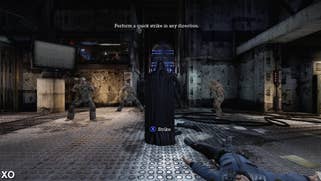
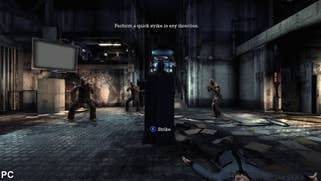






Next there's the case for Arkham Asylum, a game that does use a 30fps cap. Again we have v-sync engaged on both PS4 and Xbox One, but in placing a performance ceiling at 30fps we see the rise of another familiar issue: frame-pacing. In other words, Arkham Asylum trades one problem for another. Both consoles stick to the 30fps line for lengthy segments of play, but we still see frame-times jut upwards to 16.7ms and down to 50ms (and below). It's a common affliction for games this generation using a sub-optimal implementation of half-refresh 30fps, and sadly creates a persistent judder sensation to camera movement.
Perhaps more jarring is the fact Xbox One can't hold this 30fps line in seemingly simple areas. Moving towards a new corridor of the asylum, we see drops to as low as 22fps, likely as a result of streaming the next spot, which only increases the velocity of the frame-time spikes. These drops blight Xbox One's delivery of the game from the word go: the moment the Joker escapes and you're fighting your first trio of enemies it's already sat at the 25fps line while PS4 turns in an oddly frame-paced 30fps. This is a huge disappointment, especially given the linear nature of the first game in the Arkham series.
At this point, it's clear why there were doubts surrounding this remaster package's development. The project's release status switched to 'indefinite' only a few months ago, and based on the turnout on its launch week, we can understand why. Even with the enhanced graphics to its credit, the fact remains we're staring at two messy playing experiences when it comes to simply controlling its cast - hitting some stuttering lows on Xbox One in particular.
Batman: Return to Arkham - the Digital Foundry verdict
In an ideal scenario, we'd have the best of both versions for each Arkham title in one package. Developer Virtuos adds more than it removes from Batman: Arkham Asylum and City overall, both in the texture work and quality of lighting. However it's clear there are also technical missteps that produce rougher results in places; for every upgraded skin shader or higher-grade effect, there's also a cut-back visual element - such as the crude hair transparencies, or the missing depth of field effect. The reworked character models can impress as much as confuse in this sense too, and opinions will be divided on which is truly the better interpretation of its roster.
The Return to Arkham package will please newcomers for this reason. Those with no attachment to the style of Rocksteady's originals will be none-the-wiser to its many adjustments. Sadly it's far from a perfect way to enjoy this double-bill, being available only on PS4 and Xbox One right now, where both releases have clear frame-rate issues. Sony's machine gives the smoother experience, but between Arkham Asylum's uneven 30fps frame-pacing, and Arkham City's unlocked 20-60fps range in performance, neither is close to the level of polish we'd hoped for. The Xbox One version is especially sub-par, often falling below 30fps in either game while putting out a much softer, lower resolution image.
On these grounds, the PC original still stakes a claim as the definitive release, especially if performance is a priority. It's still the only way to play either game at a locked 60fps, which ranks high on the list of missed opportunities for the PS4 and Xbox One remasters. While PC misses out on plenty of visual tweaks here, it has its own unique benefits with Nvidia's PhysX enhancements for smoke, particles and debris - a point that's still unmatched on console. We'd be remiss to call it an absolute victory, given the clear improvements the remaster can bring in environmental detail, but the advantage in performance can't be overstated when compared to the troubled frame-rates on console.
As a package, Batman: Return to Arkham is a mixed bag: improved in spots, but not without compromise. The good news is the core quality of each game holds up on PS4 and Xbox One even today, and comes complete with all DLC. Virtuos' ambition to rework both games using Unreal Engine 4 is also to be applauded here, an unprecedented step in a generation that's become reliant on releasing basic last-gen ports cranked to 1080p. As an alternative take on Arkham Asylum and Arkham City it's a fascinating case study for a comparison too, and we hope to see the game's performance issues addressed down the line.


















